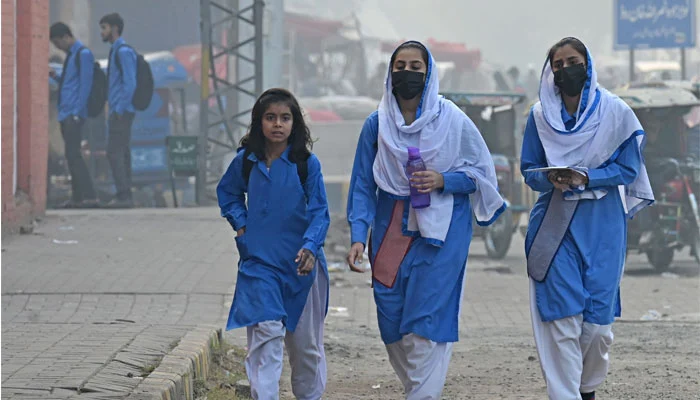Govt likely to close schools, colleges and varsities on Friday.
Businesses, other recreational spots to also remain closed on Sat.
Factories defying govt orders to be shut and heavily fined.
LAHORE: The Punjab Cabinet Anti-Smog Committee is expected to make crucial decisions, including the closure of markets and schools, in a high-level meeting chaired by interim Chief Minister Syed Mohsin Naqvi today (Thursday), as the smog situation deteriorates further in the province.
The committee’s meeting is currently taking place to mull over the implementation of Section 144 and proposals for soft smog lockdowns.
Sources said the meeting will deliberate on the proposal including the closure of schools, colleges and universities on Friday, while markets, gyms, cinemas, theatres and factories to be completely shut on Saturday as well. Restaurants will also be told to close for dine-in on Saturday with permission for only takeaway and home delivery to be granted.
The sources added that the factories defying government orders and working against the law will be considered for closure and heavy fines.
The meeting will also propose limiting public and private vehicles in Lahore, they said, adding that in government offices, only half of the employees will be asked to work.
Participants at the meeting will also be briefed about the situation of smog, with a plan for new measures to be taken to deal with the issue in light of environmental and health experts’ recommendations.
Provincial ministers, agriculture and industry, environment, information, health, transport, chief secretary, inspector general of police, chairman of planning and development board, senior member board of revenue, secretaries of concerned departments, environmental experts and health experts are expected to participate in the meeting.
Air pollution clouds over South Asia
Lahore, and most of the Punjab province, has remained gripped by heavy smog turning it into a “poisonous gas chamber” where citizens continue to face serious health problems. The Air Quality Index (AQI) of the city, in particular, remains in the top five or 10 spots, making it one of the polluted cities in the world.
Sources in the Environmental Protection Agency (EPA) revealed that a number of furnaces in northern Lahore were operating at night and using sub-standard fuel such as rubber tyres, plastic and other materials while many other factories in different industrial estates of the city were also contributing to rising air pollution.
The sources said that a very half-hearted campaign was started against smoky vehicles and EPA’s claims of using PSCA cameras to take action against smoke-emitting vehicles was just a statement.
Countries in South Asia have seen a marked increase in industrialisation, economic development, and population growth over the past two decades, leading to increased demand for energy and fossil fuels.
While sources like industries and vehicles affect most countries, certain major contributors are unique to South Asia, including solid fuel combustion for cooking and heating, human cremation, and burning of agricultural waste.
About 38% of the pollution in New Delhi this year, for example, has been caused by stubble burning — a practice where stubble left after harvesting rice is burnt to clear fields — in the neighbouring states of Punjab and Haryana.
An increase in the number of vehicles on roads as the region has developed has also exacerbated the pollution problem. In India and Pakistan, for example, the number of vehicles has increased four-fold since the early 2000s.
New Delhi, ranked the world’s most polluted capital for four years in a row by Swiss Group IQAir, has 472 vehicles per thousand population, according to government data, with almost eight million vehicles plying on its roads as of 2022.

